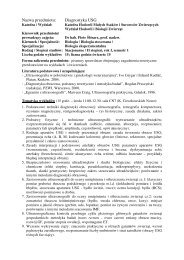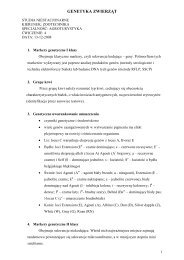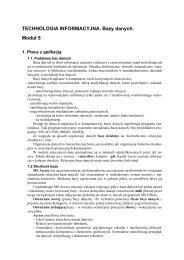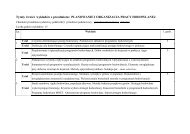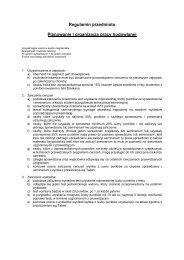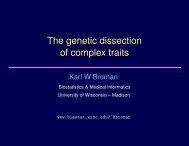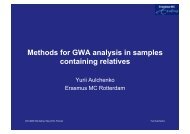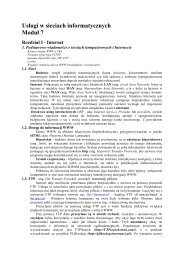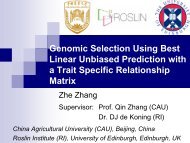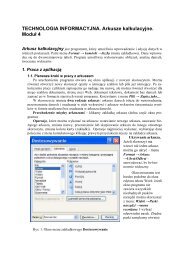The book of abstracts is available. - PoznaÅ
The book of abstracts is available. - PoznaÅ
The book of abstracts is available. - PoznaÅ
You also want an ePaper? Increase the reach of your titles
YUMPU automatically turns print PDFs into web optimized ePapers that Google loves.
14 th QTL-MAS Workshop, Poznań University <strong>of</strong> Life Sciences, Poland 2010Mapping systemic scleroderma genes in a cross between UCD200 andjungle fowl chickensWeronica Ek 1* , Anna-Stina Sahlqv<strong>is</strong>t 2 , Roswitha Sgonc 3 , Hermann Dietrich 3 , Georg Wick 3 ,Olov Ekvall 4 , Leif Andersson 1,5 , Örjan Carlborg 1 , Olle Kämpe 2 , Susanne Kerje 51 Department <strong>of</strong> Animal Breeding and Genetics, Swed<strong>is</strong>h University <strong>of</strong> Agricultural Sciences, Uppsala, Sweden.2 Department <strong>of</strong> Medical Sciences, Uppsala University Hospital, Uppsala, Sweden3 Div<strong>is</strong>ion <strong>of</strong> Experimental Pathophysiology and Immunology, Biocenter, Innsbruck Medical University,Innsbruck, Austria.4 Department <strong>of</strong> Rheumatology och Inflammation Research, <strong>The</strong> Sahlgrenska Academy, Gothenburg, Sweden5 Department <strong>of</strong> Medical Biochem<strong>is</strong>try and Microbiology, Uppsala University, Uppsala, Sweden.*Presenting author: Weronica Ek, email: weronica.ek@hgen.slu.seBackground. Systemic Scleroderma (SSc) <strong>is</strong> a rare autoimmune d<strong>is</strong>ease characterized byfibros<strong>is</strong> <strong>of</strong> skin and internal organs, such as gastrointestinal tract, lungs kidneys and heart.Scleroderma <strong>is</strong> a complex d<strong>is</strong>ease and evidence suggests that genetic factors may be involvedand that immune-regulation plays a major role. University <strong>of</strong> California at Dav<strong>is</strong> (UCD) line200 chickens develops a heritable systemic scleroderma, similar to the one in humans, and <strong>is</strong>therefore important as an animal model for the study <strong>of</strong> human scleroderma.Method. We have generated a backcross between UCD200 and the red jungle fowl (control)chickens and performed a genome-wide QTL scan to identify loci underlying the d<strong>is</strong>ease.Two approaches were used to analyze the data. Generalized linear regression on line-originQTL genotype probabilities calculated using cnF2freq (Nettelblad et al, 2009) and FlexibelIntercross Analys<strong>is</strong> (FIA), a variance component model that allows for variation within lines(Rönnegård et al, 2007). Scleroderma was scored as a binary trait, affected or not.Results. <strong>The</strong> analys<strong>is</strong> confirmed one significant QTL on chromosome 14 (OR 2.7, p Genome-wide< 0.05) and one suggestive QTL on chromosome 2 (OR 2.8, p Genome-wide = 0.06). Birdsphenotyped for early comb necros<strong>is</strong>, scored at 3-weeks <strong>of</strong> age, showed a significant peak onchromosome 12 (OR 2.9, p Genome-wide < 0.05). Scleroderma was more frequent in males (94%affected) then in females (25% affected) at 175 days <strong>of</strong> age.C. Nettelblad, S. Holmgren, L. Crooks, O. Carlborg (2009) cnF2freq: Efficient Determination <strong>of</strong> Genotype andHaplotype Probabilities in Outbred Populations using Markov Models. Proceedings to BICoB 2009, NewOrleans, LNBI 5462, pp. 307-319, Springer Verlag BerlinRönnegård, L., Besnier, F., Carlborg, Ö. 2007. An improved method for quantitative trait loci detection andidentification <strong>of</strong> within-line segregation in F2 intercross designs. Genetics 178: 2315-2326.41



